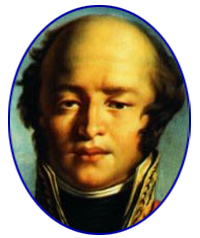

Click to see full text of the Chapter victor_ivanov@ukr.net
Argument of the Chapter
ďMarshal Louis Nicolas DavoutĒ
Early years. Study in military schools of Auxerre and Paris. Davout as a second lieutenant. Revolution. Davout as a volunteer of Yonne department. Service in Belgian army of general Dumurrier. Dutch Campaign of 1792. First defeat at Neerwinden. Participation in suppression of Dumurrierís mutiny.
Promotion. Davout as a brigade general. Victory at Viere. Refusal from the rank of division general. Resignation. Return to Mosel army of general Moreau. Campaign of 1795. Audacious raids into enemy homefronts. Friendship with general Marceau. Capitulation of Mainheim fortress and captivity. Return to military service by the end of 1796 campaign. Local success at Kehl fortress. Campaign of 1797. To Rhein. Interception of general-rebel Pichegruís mail. Acquaintance with general Dessaix.
Participation in Egyptian campaign under command Dessaix. Success at village Sauaki. Victory over troops of Mourad-Bey at Samhoud. The battle at Aboukir. Davout remains in Egypt and protests against peace treaty with Great Britain, concluded by Commander-in-Chief Kleber. In British captivity together with Dessaix. Return back home.
Rank of division general. Davout as a cavalry commander in Bruneís Italian army. Victory over Austrians at Pozzolo. Davout as general-inspector cavalry. Marriage with sister-in-low of Napoleonís sister. Davout as the commander of Consular Guard foot grenadiers. The Boulogne camp. Forming of 3-rd Army Corps. Marshal of the Empire. Animosity with marshal Berthier.
Preparation to the campaign of 1805. Standing against Austria. Skilled maneuvers of Grand Army Corpss, aimed at encircling of Mackís army in Ulm. Crushing defeat of Merveldtís Austrian Corps at Mariazell. Davout shows wonderful forced march. The battle at Austerlitz. Participation in maneuver ęLionís jumpĽ. Marshal Davout as the general-colonel of Emperorís Guard.
Prussian Campaign of 1806. General characteristics of Prussian army. Pre-war political maneuvers. ęBatallion squareĽ of Grand Army. Plans and original actions of the sides. Triumph at Auerstaedt. Desperate courage of generals Gudin and Morand. Campaign against Russian army in Western Poland. Bloody, but resultless battle at Pultusk. Plans of the sides for campaign of the year 1807. Preysisch-Eylau. Attack of marshal Davoutís troops at Serpallen. Marshal Davout fails to make roundabout maneuver of enemy left flank. Prelude to Friedland. Appointment of general-government of Grand Duce of Warshaw. Title of Duke of Auerstaedt.
Austrian Campaign of 1809. Sluggish Head of Staff Berthier, who almost caused defeat of marshal Davoutís Corps. First collision with Archduke Charles ay Abensberg. Breakthrough to Ratisbonne. Tactical mistakes of Austrian command. The battle at Eckmuhl. Transfer of marshal Davoutís Corps in Army reserve. Participation in Wagramís battle. Tactical situation of the second day of the battle. Attack at Markgraff-Noesiedl. Title of Prince of Eckmuhl. Marshal Davout as the governor of Hanseatic cities.
Preparation to Russian campaign. Operation plans. Invasion into Russia. Unsuccessful attempts to encircle 2-nd Western army of Bagration. The battle at Smolensk. Death of general Gudin. Avenue of approach to Moscow. Dislocation of both armies before the general battle. Plan of marshal Davout and plan of Napoleon. Attack at Bagrationís positions. Contusion. Marshal Davoutís troops as rearguard of retreating Grand Army. Crushing defeat at Viasma. Marshal Davout leaves Ney in trap at Orsha. Crossing Beresina.
Campaign of 1813. Marshal Davoutís role in operational plans of Napoleon. Defence of Dresden. Forces of Davout. Danish Auxiliary Corps. Forces of the allies. Operational plans of the sides. Opening of summer campaign of 1813. Local victory at Lauenburg. Seizure of Schwerin. Avenoe of approach to Delvenau. Advance at Rostock. The battle at Konow with Swedish cavalry. Influence of marshal Oudinotís Corps defeat at Gross-Beeren on situation of Davoutís army. Moving to the line of Schwerin-Wismar. Allied Commander-in-Chief Walmoden lost his chance to crush marshal Davoutís forces on their march. Retreat of the French to the northern bank of Elbe. The battle at Tesdorf. General Wathier. Cavalry battle at Gudow. Secret of success of marshal Davoutís defence activities. New operation plan of the allies. The battle at Weisser Hirsch. Combat reconnaissance at Gudow. Occupation of Hamburg The allies send new troops. Slowness of Danish command. Skirmish at Steinhorst. Triumph of Danish weapons at Boden. The battle at Bornhoved. Allies raid at Sehested. ęIron marshalĽ. Capitulation of Hamburg.
Resignation. Marshal Davout as the minister of war during the One Hundred days. The last battle at Rocquencourt. Capitulation in Saint-Cloud. Defending marshal Ney from unfair trial. Nobility and brevity of marshal Davout. Return of previous status. Analysis of military leaderís career of marshal Davout.
Maps of the Chapter ďMarshal Louis Nicolas DavoutĒ
1. Situation in the Central_Europe (October 11-14, 1805).
2. Battle at Mariazel.
3. Situation in Central Europe (November 25, 1805).
4. Situation at Auerstaedt.
5. The main phases of Auerstaedt battle.
6. The Polish campaign of 1806-1807.
7. The days before Friedland (June 6 1807).
8. The five-day campaign, 1809.
9. Battle at Amberg.
10. Battle at Ebersberg Ė Eckmuhl.
11. The main French offensive at Campaign of 1809.
12. Situation at Eckmuhl (April 22, 1809).
13. The main French offensive in campaign of 1809.
14. Situation at Russia (June 23 1812).
15. Battle at Mogilew.
16. Situation at Russia (November 1 Ė December 5, 1812).
17. The beginning of Davoutís campaign 1813.
18. The fragment of a battlefield ( vicinities of Buchen).
19. The continuation of Davoutís campaign 1813.
20. The fragment of a battlefield ( vicinities of Sehested).
Illustrations of the Chapter ďMarshal Louis Nicolas DavoutĒ
1. Portrait of Davout in Revolution.
2. Portrait of general Marceau.
3. General Dessaix at Egypt.
4. Napoleon at Egypt.
5. Portrait of marshal Davout.
6. Portrait of general Bourcier.
7. Portrait of Duke of Brunswick
8. Portrait of general Friant.
9. Portrait of general Morand.
10. Portrait of Frederic Guillaume III.
11. Portrait of general Ostermann-Tolstoy.
12. Portrait of general Palen.
13. The Russian unicorn.
14. Portrait of general Ermolow (painted by Dow).
15. The Russian mortar.
16. Portrait of general Bennigsen.
17. The Arms of Duke Auerstaedt.
18. Portrait of Eugene Beauharnais.
19. Portrait of general erl Radetsky.
20. Portrait of Jerome Bonaparte.
21. Portrait of general Dessaix.
22. Portrait of general Junot.
23. Portrait of general Gudin.
24. Portrait of general Compans.
25. The Russian artillery at Borodino.
26. Portrait of general Bagration.
27. Portrait of general Gerard.
28. Portrait of general Lutzow.
29. The Danish cavalryís uniforms:
ē Ranl of the Guard light cavalry;
ē Uhlan;
ē Dragoon.
30. Portrait of general Rapp.
31. The battle of general Exelmans.
32. Portrait of general Sohr.
33. Marshal Davoutís grave.
The structure of military-historical monograph
ęMilitary campaigns of Napoleonís marshalsĽ
Preface.
Introduction.
Chapter 1 Ė marshal Jean Baptiste Jules Bernadotte, Prince of Ponte Corvo (1763-1844).
Chapter 2 Ė marshal Louis Alexander Berthier, Prince of Neuchatel, Prince of Walange, Prince of Wagram (1753 Ė 1815).
Chapter 3 Ė marshal Jean Baptiste Bessieres, Duke of Istria (1768-1813).
Chapter 4 Ė marshal Guillaume-Marie-Anne Brune (1763-1815).
Chapter 5 Ė marshal Victor Claude Victor-Perrin, Duke of Belluno (1764 Ė 1841).
Chapter 6 Ė marshal Laurent Gouvion Saint-Cyr, marquess (1764-1830).
Chapter 7 Ė žŗūÝŗŽ Emmanuel Robert de Grouchy, marquess (1766-1847).
Chapter 8 Ė marshal Louis Nicolas Davout, Duke of Auerstaedt, Prince of Eckmuhl (1770-1823).
Chapter 9 Ė marshal Jean Baptiste Jourdan, count (1762-1833).
Chapter 10 Ė marshal Francois Etienne Christophe Kellermann, Duke de Valmy (1735-1820).
Chapter 11 Ė marshal Jean Lannes, Duke of Montebello (1769-1809).
Chapter 12 Ė marshal Francois Joseph Lefebvre, Duke of Danzig (1755-1820).
Chapter 13 Ė marshal Jacques-Etienne-Joseph-Alexander Macdonald, Duke of Tarente (1765-1840).
Chapter 14 Ė marshal Auguste Frederic Louis de Viesse Marmont, Duke of Ragusa (1774-1852).
Chapter 15 Ė marshal Andre Massena, Duke of Rivoli, Prince of Essling (1758-1817).
Chapter 16 Ė marshal Bon Adrien Jeannot Moncey, Duke of Conegliano (1754-1842).
Chapter 17 Ė marshal Adolphe Edouard Casimir Joseph Mortier, Duke of Treviso (1768-1835).
Chapter 18 Ė marshal Joachim Murat, King of Naples (1767-1815).
Chapter 19 Ė marshal Michel Ney, Duke of Elchingen, Prince of Moskwa (1769-1815).
Chapter 20 Ė marshal Pierre Francois Charles Augerau, Duke of Castiglione (1757-1816)
Chapter 21 Ė marshal Dominique-Catherine Perignon, marquis de Grenade (1754-1818).
Chapter 22 Ė marshal Joseph Antoine Ponyatovsky, prince of Poland (1763-1813).
Chapter 23 Ė marshal Jean-Mathieu Philiber Serurier (1742-1819).
Chapter 24 Ė marshal Nicolas Jean de Dieu Soult, Duke af Dalmatia (1769-1851).
Chapter 25 Ė marshal Louis Gabriel Suchet, Duke of Albufera (1770-1826).
Chapter 26 Ė marshal Nicolas-Charles Oudinot, Duke of Reggio (1767-1847).
Conclusions.
Literature.